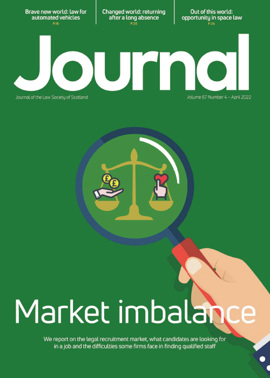AML: the new benchmark
Fraser Sinclair is head of AML for MacRoberts LLP and runs the AML consultancy brand AMLify.
 In my time as the Law Society of Scotland’s first AML risk manager, I inspected firms of different sizes and exposure to AML risk, and almost always found well-intentioned MLROs who understood the spirit of the regulations and guidance, but were forgivably perplexed by the parameters.
In my time as the Law Society of Scotland’s first AML risk manager, I inspected firms of different sizes and exposure to AML risk, and almost always found well-intentioned MLROs who understood the spirit of the regulations and guidance, but were forgivably perplexed by the parameters.
My new partnership with the Society to deliver a Certified Specialist in AML course, and my consultancy work under the AMLify brand, are a part of my commitment to using my own experience and knowledge to help solicitors comply in a way which is risk based and will help them contribute to a national culture that is prohibitive to the would-be money launderer.
This first in a set of quarterly AML articles is a briefing on the Society’s new sectoral risk assessment.
Overview
Risk assessments are mandated at various levels by the UK Money Laundering Regulations. Our national risk assessment should inform the sectoral risk assessment, and our sectoral risk assessment informs our “Practice Wide Risk Assessment (PWRA)”. In this way, our policy and procedures for AML should necessarily be the end point of a succinct and coherent approach from top to bottom. This makes the Society’s new sectoral risk assessment a document for the AML canon.
In the four years between the Society’s previous sectoral risk assessment and the newest release, a dedicated AML team was created, the AML certificate annual return was embedded, new LSAG guidance was released, a TCSP thematic was completed, and the Society began a more enhanced approach to AML-focused inspections. That’s some serious action from which to draw more acute assessments.
In fact, the sectoral assessment (below) plays many of the old hits.
Those exasperated by the due diligence involved in offering registered offices to national charities and Scouts branches might be glad to see TCSP specifically rated as moderate risk, and it will be no surprise to most to see conveyancing retain a top spot in the higher risk section.
Remember though, these assessments should not translate directly to “nailed-on” risk assessments of your clients and matters. Risk assessment should always be a holistic exercise in consideration of various factors.
It was interesting to note that PEPs have been placed in the “moderate inherent risk” category due, seemingly, only to a limited number of matters of concern being reviewed by the Society. PEPs remain ringfenced in the UK regulations for enhanced due diligence due to their presumed higher inherent risk, and firms must now juggle this with their own regulatory obligation to consider the sectoral assessment’s stipulation that PEPs represent a moderate inherent risk.
It was also interesting to see that sham litigation is of limited inherent risk. The Society has recently responded to a UK-wide consultation that bogus litigation “appears so often as a headline-grabbing money laundering technique”, and that not pulling some litigation within the ambit of the regulations in future “may be a weakness in the UK’s AML defences”. Further, the assessment that there have not been “examples to date of potentially concerning or suspicious activity in this area of legal practice” should get a second glance – litigation is not in the AML-regulated sector and presumably there has been relatively little review of litigation files at all on inspection. If you don’t look for something and then don’t find it, to what extent is that the basis for a conclusion?
How to use it
Notwithstanding cavils like these, the sectoral assessment should be read carefully in line with your own PWRA and policies and procedures. The decision to put in a specific section on the dangers of certain funds of Chinese origin should induce those in conveyancing especially to have a further think on the subject (I recommend further reading – this issue is not straightforward).
You cannot implement a risk-based approach without first understanding the risks you face. This makes the Society’s sectoral risk assessment a key weapon in the arsenal. My own tip here is to revisit your PWRA, specifically noting each of the factors listed in the sectoral assessment; write about your own exposure to them and, as applicable, any mitigating policy and procedure. You may gain fresh perspective on your own firm’s AML regime.
If you feel that you could use support with AML, please see the Society’s new Certified Specialist course in AML, or contact fraser.sinclair@Macroberts.com for queries on support, audit, training and consultancy.
| Limited inherent risk | Moderate inherent risk | Substantial inherent risk |
|---|---|---|
| Sham litigation | Trust or company service provision (TCSP) | Conveyancing |
| Notarial services | Misuse of the client account | High risk industries |
| Cryptocurrency | PEPs | Volume, nature and value |
| High client turnover | Familiar clients | High risk geography |
| Non-face to face delivery | Underlying client obscured | Combination of services |
| Clients using in and out of scope services | Pandemic related risks | Risks relating to Chinese individual direct investment activity and high value goods |
| Mergers and acquisitions |
Perspectives
Features
Briefings
- Criminal court: Thom bar still applies
- Licensing: tighter rules for the pet trade
- Insolvency: Transition from the COVID measures
- Tax: What did the Spring Statement bring?
- Immigration: Providing a home for Ukrainians
- Scottish Solicitors' Discipline Tribunal
- Property: RCI – what does it involve?
- In-house: Looking for a star







